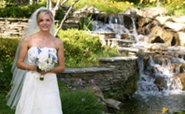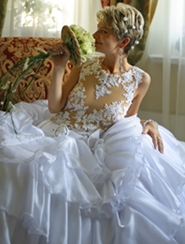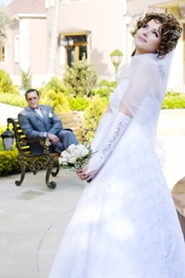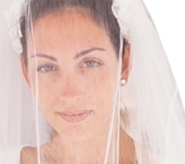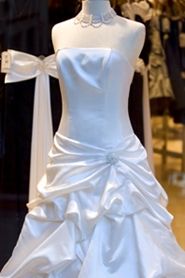Wedding Gown Terminology
Rochester Wedding gown terminology

Wedding Gown Terminology
Fabrics
Batiste- is a summery, cotton material.
Brocade- is a heavy fabric, with interwoven, embossed patterns.
Charmeuse- is classically made of silk, and is a soft, lightweight cloth.
Chiffon- is sheer, often layered with more chiffon or over a heavier fabric.
Chintz- is a cotton fabric, printed and with a glazed finish.
Crepe- is often used when a draping effect is wanted. Made of thin silk, rayon, polyester or cotton.
Crepe de Chine- is a light, thin fabric - usually used in making blouses.
Crinoline- is netting used underneath skirts for fullness.
English net- is fine sheer cotton netting.
Eyelet- is open-weave embroidery, used for ornamentation.
Faille- is a heavier fabric used is cooler-weather weddings. Slightly stiff, with a ribbed weave.
Georgette fabric- is silk or synthetic crepe with a dull texture.
Illusion- is a silk tulle used primarily for veils.
Jersey- is made of silk or a blend, and is very fluid.
Linen- is made of natural linen or a blend, as it wrinkles easily, and is used for a heavier design.
Net- is used, often at necklines or on veils, when a sheer effect is desired.
Moiré- is silk taffeta patterned to glisten as if wet.
Organdy- is sheer silk or rayon fabric, often printed or embroidered.
Organza- is a sheer, stiff fabric, often appliquéd.
Peau de soie- is a silk blend, which holds its shape, yet has a soft feel.
Raw silk fabric- is characterized by slubs in the material.
Satin- usually has a high gleam, and a more constructed shape.
Silk-faced satin- is smooth fabric with a glossy front and a dull back.
Silk gazar- is silk organza with a square weave.
Shantung- is a silk or man-made fabric with a rough texture (slubs).
Taffeta- is generally a heavier fabric, with a stiffer feel.
Tulle- looks like veiling, and is usually layered, for a ballerina look.
Velvet- is a winter fabric, usually used in simpler styles.
Laces
Alencon lace- is needlepoint lace, in a net background.
Battenburg lace- is attached, coarse linen lace.
Bobbin lace- is hand-made, using small bobbins.
Brussles lace- is light and delicate, and also very expensive.
Chantilly lace- is fragile made on fine mesh, in web-like patterns. With scalloped edges.
Cluny lace- is made of fine linen thread, in open designs.
Cut-outs- are when the lace shows there is no fabric beneath.
Duchesse lace- is a type of bobbin lace with floral designs and raised work.
French lace- is machine made lace to simulate hand-made French lace.
Honiton lace- is similar to Duchesse, but is sewn to mesh fabric.
Guipure- heavy lace made on coarse mesh, with large patterns.
Renaissance- is a heavy, flat lace laid out in a pattern.
Rose-point lace- is fine lace with motifs of flowers and scrolls.
Schiffli embroidery- is machine-made lace, in very fine patterns.
Spanish- has a flat design of roses on net - used for mantillas.
Venise or Venetian point lace- is heavy cotton or linen lace.
Silhouettes
A-line or Princess gown- has vertical seams from the shoulder to the hem. It has no waistline. These gowns are much like sheaths.
Ante-bellum waist- drops two inches from the natural waistline at sides to a point in the center front.
Apron overskirt- is joined at the back of the gown and falls across the front.
Asymmetrical waist- is when the fabric drops to one side of natural waist.
Ballerina skirt- is a full skirt of many layers, which reveals the ankles.
Ball Gown- is fitted from the shoulders to the waist, with a full skirt.
Basque gown- is fitted at the waist, forming a V in front.
Blouson bodice- has fullness above waist, drooping at or below the waist.
Bolero jacket- ends at or above the waistline, worn open in front.
Bouffant skirt- is full and flaring.
Bubble effect- is when the skirt is caught up and attached to the lining.
Circular skirt- attaches at waist and falls to a complete circle at the hem.
Drop waist- is long and straight to the waist of the gown, which falls several inches below your own waist, then full below.
Empire- style has a scooped neckline and a high waistline. The skirt falls from above your waist.
Fitted bodice- is form-fitting upper part of gown.
Flounce- is fabric, wider than a ruffle, gathered and attached to skirt.
Hoopskirt- is a very full skirt, held out with hoops under the fabric.
Keyhole- is a tear-shaped opening, referring to a neckline to back of gown.
Mermaid or Trumpet skirt- is tightly fitted from the waist to the knee (or slightly below) then flared.
Peplum- is a short flounce or overskirt attached at the waistline.
Raised waistline- is slightly above the natural waistline.
Redingote- is a dress or coat, belted, open along the front to reveal dress or petticoat.
Sheath dress- is a very narrow gown, with no waist.
Shirred waist- has gathered fabric to form a panel around the waist.
Tiered skirt- has a series of layers that fall in graduated lengths.
Tulip skirt- is a layered skirt which unfolds in the front.
Necklines
Bateau/Sabrina- follows the collarbone along the top of your shoulders.
Bertha- collar is a cape of fabric or lace attached to neckline for shawl look.
Cameo- neckline had a decorative cameo at the center front.
Decolletage- neckline is a plunging V neckline, designed to flatter cleavage.
High collar or Wedding band collar- is a band which fits closely to the neck.
Jewel- collar has a high, round neckline.
Off the Shoulder gown- is below the shoulder, with sleeves.
Portrait neckline- is also off the shoulder, but has a band of fabric along the top, usually with no sleeves.
Queen Anne- neck is high at the back of the neck, falling away in the front to a sweetheart shape.
Queen Elizabeth- neck is high at the back of the neck, and falls to a point in front.
Scoop- neckline is rounded.
Strapless- neckline reveals the entire shoulders, usually worn with a jacket or wrap.
Sweetheart- neckline is shaped like the top half of a heart.
V-neck- is just that.
Sleeves
Balloon sleeve- is a very large puff sleeve, fitted at the elbow.
Bell sleeve- is narrow at the top and has a bell flare at the bottom.
Bishop sleeve- becomes fuller to the wrist, which is folded back to a wide cuff.
Bow sleeve- is worn on or off the shoulder, constructed of looped fabric.
Butterfly sleeve- is a wide, flaring, stiff sleeve, gives a cape effect.
Cap sleeve- is short and fitted.
Dolman sleeve- has a long armhole (sometimes from shoulder to waist) and is fitted at wrist for a cape look.
Double puff- has a band in the middle dividing puff into two.
Fitted sleeve- is full at shoulder then fitted at wrist.
Gibson sleeve- is full at shoulder then fitted at wrist.
Juliet sleeve- is long, fitted, with a puff at the top.
Leg-o-Mutton sleeves- are very full from the shoulder to the elbow, then fitted to the wrist.
Melon sleeve- is very full from the shoulder to elbow.
Peek-a-boo sleeve- is a puffed sleeve which reveals another fabric underneath.
Petal sleeve- is a short sleeve, with many layers.
Poet sleeve- is very full to the wrist.
Pointed sleeve- is a long fitted sleeve that falls to a point over the hand, and may attach to a finger.
Puff sleeve- is a short, full sleeve, gathered at the bottom.
Three-quarter sleeve- ends between elbow and the wrist.
Lengths
Short- falls just above the knee.
Knee length- as it sounds, just covers the knee.
Ballerina or Mid-calf- falls between the knee and the ankle.
Tea length- has the hem several inches above the ankles.
Floor length- the hem barely sweeps the floor.
High/Low- is knee-length in the front, falling to floor-length in the back.
Types of Trains
Attached- train which simply falls from the back end of the skirt. These are the most preferred by brides.
Watteau- train falls from the back yoke, or from around the waist.
Capelet- train falls from the back shoulder. After the ceremony, any of these styles can be bustled, or hooked up so that they are the same length as the back of the dress. This allows for easy movement.
Detachable- train begins at the waistline and can be removed.
Lengths of Trains
Brush- train barely sweeps the floor as you walk.
Sweep- falls about six inches onto the floor, and is usually semi-formal.
Court- train extends one foot behind the gown.
Chapel- length falls up to twenty-two inches onto the floor.
Cathedral length- falls further than twenty-two inches in length. These are usually found at only the most formal weddings. Semi-cathedral are from 54 to 66 inches (from the waist), cathedral is from 78 to 90 inches, and extended cathedral is over twelve feet from the waist.
Future Upcoming
Rochester Bridal Shows
![]()
![]()
Click here for your free tickets
![]()
Click here for your free tickets
![]()
Presented by

Rochester's wedding planning site!
![]()


